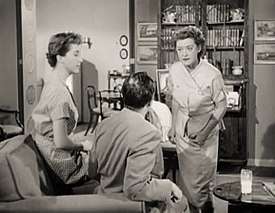The Star (1952 film)
| The Star | |
|---|---|
 Theatrical release poster | |
| Directed by | Stuart Heisler |
| Produced by | Bert E. Friedlob |
| Screenplay by |
Dale Eunson Katherine Albert |
| Starring | Bette Davis |
| Music by | Victor Young |
| Cinematography | Ernest Laszlo |
Production company |
Bert E. Friedlob Productions |
| Distributed by | 20th Century Fox |
Release date |
|
Running time | 90 minutes |
| Country | United States |
| Language | English |
| Box office | $1 million (US)[1] |
The Star is a 1952 American drama film directed by Stuart Heisler and starring Bette Davis. The plot tells the story of an aging, washed up actress who is desperate to restart her career. Even though the film was a critical and commercial failure, Bette Davis received an Academy Award nomination for Best Actress.
Plot
Academy Award-winning star Margaret "Maggie" Elliot (Bette Davis) is a bankrupt actress of a certain age struggling to accept her new non-wealthy reality. She is in denial, and confident she can somehow build herself up again and re-launch her career to its earlier brilliance. After suffering another big disappointment while vainly striving to get that last one good role, she gets drunk, is arrested for DUI, and spends a night in jail. She is bailed out by Jim Johannsen (Sterling Hayden), a younger former actor whom she had helped in the past. Jim, now comfortably settled as the owner of a boatyard, admits that he has loved her ever since those days and, helped by Margaret's daughter Gretchen (Natalie Wood), tries to help Margaret see that her big screen days as a famous actress are already over. She reluctantly tries to work as a saleswoman in an upscale department store, but overhearing some unkind gossip from two customers wounds her pride and she runs out. Her old agent manages to get her a screen test for a role in a film she'd always wanted to play. She is offered and takes a screen test for a supporting role, believing that if she plays that character as a sexy younger woman -- rather than the middle-aged frump she is seen as by the studio -- she might be able to win the more coveted lead role. It does not work out.
At a Hollywood party thrown by her agent, she is offered a role in a new film about a fallen star who can't face the fact that it's all over. This new script is dedicated to washed-up actors and actresses who are obsessed by their former glory, by what they used to look like, what kind of an impression they’d make to stay on top, and how they behaved -- demanding, bribing, power-hungry. It would be a story about those who can't look down and can't accept that their moment of glory is over and that the world has passed them by. Hearing the pitch delivered right to her face, and that she'd be the perfect actress to play the role, seems to have finally helped Margaret realize the cold truth about her future. She realizes that her film career is indeed over, and she flees the party to the open arms of Jim and the love and acceptance of her daughter, from whom Margaret had previously desperately tried to shield her failing career.
Cast
- Bette Davis as Margaret Elliot
- Sterling Hayden as Jim Johannsen
- Natalie Wood as Gretchen
- Warner Anderson as Harry Stone
- Minor Watson as Joe Morrison
- June Travis as Phyllis Stone
- Paul Frees as Richard Stanley
- Robert Warrick as R.J., aging actor at party
- Barbara Lawrence as Herself
- Fay Baker as Margaret's sister
- Herb Vigran as Margaret's brother-in-law, Roy
Production
Katherine Albert and her husband Dale Eunson reportedly based the Margaret Elliott character on Joan Crawford, whose long friendship with the couple was ending as production began. Although it is sometimes said that she turned the role down, it was never offered to her. Bette Davis, who long publicly disdained Crawford, thus eagerly took it.[2]
Crawford retaliated after the Eunsons sent their 17-year-old daughter Joan Evans to the actress in the hope that Crawford would talk her out of getting married to a man they disapproved of. Instead of doing so, Crawford arranged the wedding, held it in her house, and called the Eunsons afterwards to tell them about it. "She set the whole thing up behind our backs," Albert complained. "She called the judge, and the press. She didn't invite us to our own daughter's wedding."[2]
See also
References
- ↑ 'The Top Box Office Hits of 1953', Variety, January 13, 1954
- 1 2 Looney, Deborah (2005). "The Star (1952)". Turner Classic Movies. Retrieved March 16, 2017.
